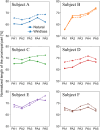Direct visualization and measurement of the plantar aponeurosis behavior in foot arch deformation via the windlass mechanism
- PMID: 38642017
- PMCID: PMC11826301
- DOI: 10.1002/ca.24171
Direct visualization and measurement of the plantar aponeurosis behavior in foot arch deformation via the windlass mechanism
Abstract
The plantar aponeurosis (PA) is an elastic longitudinal band that contributes to the generation of a propulsive force in the push-off phase during walking and running through the windlass mechanism. However, the dynamic behavior of the PA remains unclear owing to the lack of direct measurement of the strain it generates. Therefore, this study aimed to visualize and quantify the PA behavior during two distinct foot postures: (i) neutral posture and (ii) windlass posture with midtarsal joint plantarflexion and metatarsophalangeal joint dorsiflexion, using computed tomography scans. Six healthy adult males participated in the experiment, and three-dimensional reconstruction of the PA was conducted to calculate its path length, width, thickness, and cross-sectional area. This study successfully visualized and quantified the morphological changes in the PA induced by the windlass mechanism, providing a precise reference for biomechanical modeling. This study also highlighted the interindividual variability in the PA morphology and stretching patterns. Although the windlass posture was not identical to that observed in the push-off phase during walking, the observed PA behavior provides valuable insights into its mechanics and potential implications for foot disorders.
Keywords: biomechanics; computed tomography; foot; kinematics; models; plantar.
© 2024 The Authors. Clinical Anatomy published by Wiley Periodicals LLC on behalf of American Association of Clinical Anatomists and British Association of Clinical Anatomists.
Figures







Similar articles
-
Estimating the paths and mechanical behaviors of the plantar aponeurosis during dynamic movements using a multiple-marker foot model incorporating anatomically-detailed plantar aponeurosis morphology.Gait Posture. 2025 Mar;117:283-291. doi: 10.1016/j.gaitpost.2025.01.007. Epub 2025 Jan 11. Gait Posture. 2025. PMID: 39826414
-
The rise of the longitudinal arch when sitting, standing, and walking: Contributions of the windlass mechanism.PLoS One. 2021 Apr 8;16(4):e0249965. doi: 10.1371/journal.pone.0249965. eCollection 2021. PLoS One. 2021. PMID: 33831112 Free PMC article.
-
Changes in length of the plantar aponeurosis during the stance phase of gait--an in vivo dynamic fluoroscopic study.Ann Anat. 2014 Dec;196(6):471-8. doi: 10.1016/j.aanat.2014.07.003. Epub 2014 Jul 29. Ann Anat. 2014. PMID: 25113063
-
Functional anatomy and imaging of the foot.Ital J Anat Embryol. 2001 Apr-Jun;106(2):85-98. Ital J Anat Embryol. 2001. PMID: 11504250 Review.
-
The relationship between static and dynamic foot posture and running biomechanics: A systematic review and meta-analysis.Gait Posture. 2019 Jul;72:109-122. doi: 10.1016/j.gaitpost.2019.05.031. Epub 2019 Jun 1. Gait Posture. 2019. PMID: 31195310
Cited by
-
Regional variations in plantar fascia elasticity and their association with pain in plantar fasciitis: a cross-sectional study.Sci Rep. 2025 Aug 20;15(1):30568. doi: 10.1038/s41598-025-15760-9. Sci Rep. 2025. PMID: 40835661 Free PMC article.
References
-
- Abrahams, P. H. , Spratt, J. D. , Loukas, M. , & Van Schoor, A. N. (2013). McMinn and Abrahams' clinical atlas of human anatomy. Elsevier/Mosby.
-
- Behling, A. V. , Rainbow, M. J. , Welte, L. , & Kelly, L. (2023). Chasing footprints in time—reframing our understanding of human foot function in the context of current evidence and emerging insights. Biological Reviews of the Cambridge Philosophical Society, 98(6), 2136–2151. 10.1111/brv.12999 - DOI - PubMed
MeSH terms
Grants and funding
LinkOut - more resources
Full Text Sources
Medical

